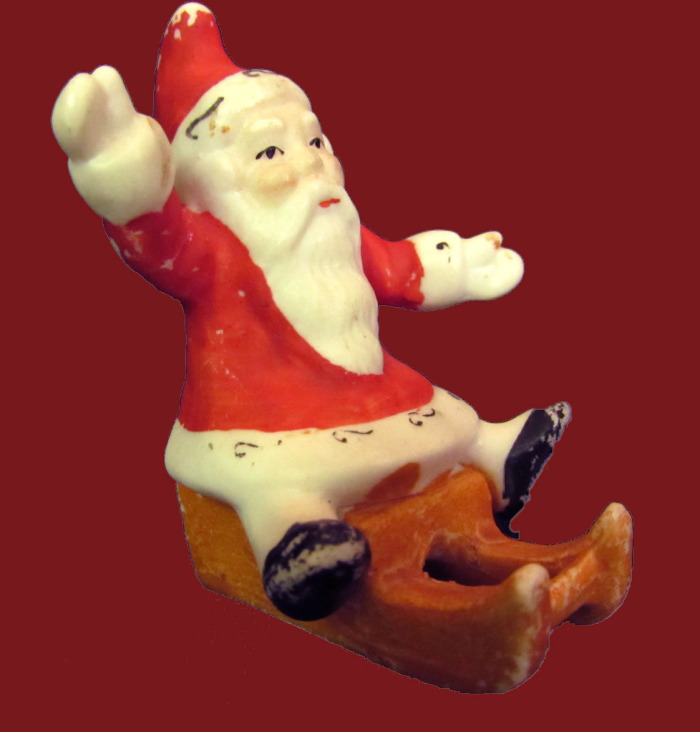


However, the figurines were low quality, and the run was unsuccessful. For a short time after the war was over, Snow Babies were manufactured in the United States and England. German manufacturing of Snow Babies stopped again at the start of World War II, and American demand for the product dropped. Although the Japanese figurines had less detail than the German Snow Babies, they were able to grow a market because of the post-war anti-German sentiment. , Japanese manufacturers began producing reproductions of Snow Babies. In the 1930s under the direction of the Shackman Company in NYC Production of the figurines in Germany was halted during World War I so that the factories could contribute to the war effort, and resumed when the war was over. Between 19, Snow Babies grew in popularity in England where they were used as cake decorations, and the United States where they were featured in women's magazines for use as Christmas decorations. Snow Babies were initially only sold in Germany, but in the 1900s German manufacturers began exporting them to England and the United States. The public's fascination with Marie and the discovery of the North Pole in 1909 helped popularize the figurines. She was the first non-indigenous baby to be born that far north (13 degrees south of the pole ), earning her the nickname "snow baby" from the Inuit. The release of the Snow Baby figurines coincided with the birth of Admiral Robert Peary's daughter in Greenland while he was on an expedition to the North Pole in 1893. They were originally manufactured by Hertwig and Company, but other porcelain factories in Germany began creating the figurines soon after. Snow Babies were created as reusable cake toppers in the 1890s by Johann Moll, a German confectioner, based on early nineteenth century sugar dolls used as Christmas decorations. In the late 1980s an American company called Department 56 began producing a new line of Snow Babies in Taiwan. In the 1920s, Japanese manufacturers began to produce Snow Baby replicas, though they were generally of a lesser quality than those made in Germany. With the onset of World War I, production stopped when it resumed after the war ended, the snow babies were less finely detailed in their porcelain and finish. The oldest Snow Babies were manufactured in Germany in the 1890s, and were typically either all white with a painted face, or painted in pastel colors. Figurines of other characters were also made, including Santa Claus, elves and animals such as penguins and polar bears. The traditional snow baby is made of unglazed biscuit porcelain (or bisque) and shows a child dressed in a snowsuit the suit itself is covered in small pieces of crushed bisque, giving the appearance of fallen snowflakes. The classic collection began with the first snow babies and continues today, with one example being 2006’s “Christmas Caravan.” If you own a classic Snowbaby, hold on to it, as it may be worth far more in a few years than it is today.A Snow Baby (or Snowbaby) is a small figurine, usually of a child, that depicts some aspect of the Christmas holidays or of winter sports. Classic Snowbabiesĭepartment 56’s classic Snowbabies collection includes all Snowbabies that aren’t part of any other special collections, such as standard figurines, music boxes and water globes. Currently, these increasingly difficult to find items each cost between $50 and $100 depending on their pose. In a catalog dated to 1914, Snowbabies were referred to as “Alaska Tots.” Back then, these lovely one-and-three-quarter inch figures were valued at 90 cents a dozen. Hertwig and Company were the original manufacturers, but soon after, other porcelain factories in Germany started producing similar figurines. Their design was based off of sugar dolls used in the early nineteenth century as Christmas decorations. The First Snow Baby FigurinesĪccording to Carouselgifts, German confectioner Johann Moll created the predecessors to today’s Snowbabies in the 1890s as reusable cake toppers. Snowbaby collectors have been around since day one, making retirement of unique and rare designs that much more significant to serious collectors. Department 56, a collectible company headquartered in Minnesota, released the first batch of Snowbabies in 1986.


 0 kommentar(er)
0 kommentar(er)
